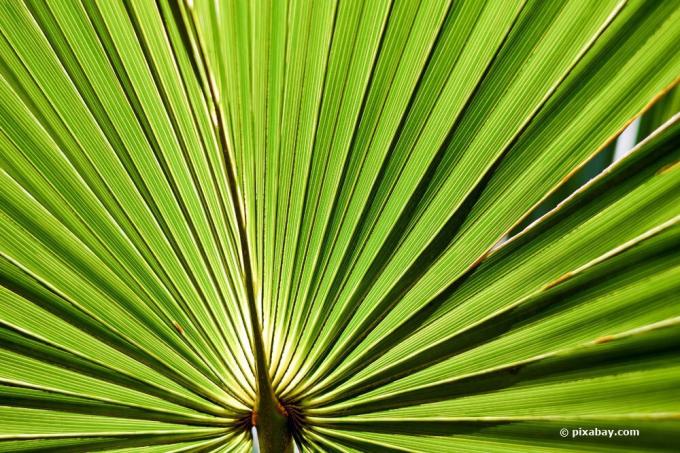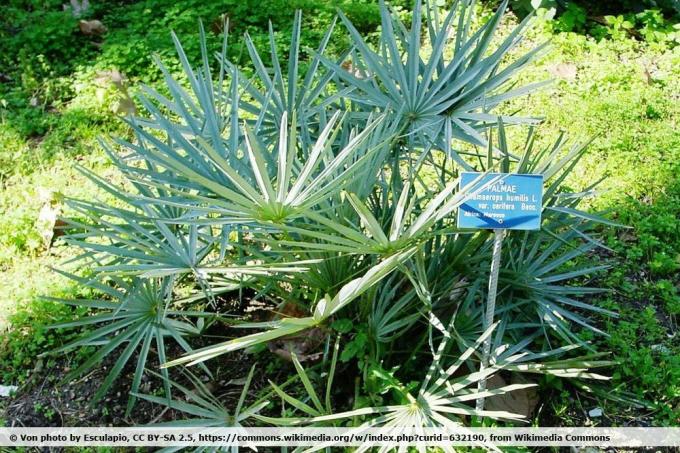
table of contents
- Hardy palms
- Winter or frost hardy
- Tips for winter protection
- Hardy palms down to -25 ° C
- Palm trees from A - B
- Palms from C - G
- Palms from H - N
- Palms from P - W
Palms (Palmae) belong to the palm-like family (Arecales). They are among the first known plants and are now the symbol of vacation, sun, beach and sea. More and more hobby gardeners get that holiday feeling and a piece of the Mediterranean way of life in their garden, on the balcony or terrace with a palm tree. But which species are suitable for Central European regions? Are there any hardy palms at all? We will introduce you to eleven suitable varieties and give you tips on how to care for them.
Hardy palms
If you have a palm tree in your garden, you will not only be confronted with admiring looks from neighbors and guests, but also with questions about caring for the impressive plants. The question is often asked whether the palm is winter and frost-resistant, because the Central European climate differs significantly from that of the original palm regions.
Winter or frost hardy
The terms “frost hardy” and “winter hardy” are used identically over and over again. However, that is not true.
Frost hardy means that a plant has no problems with the winter temperatures that are common in Germany. Even temperatures down to -40 ° C do not affect frost-hardy plants. Only long permanent frosts can damage these plants. However, frost-hardy plants can hardly deal with changing temperatures and moisture. The usual Central European winter weather means an enormous challenge for frost-hardy plants.
Hardy plants, on the other hand, have no problems with the typical German winter with fluctuating temperatures and the usual dirty weather.
Winter hardiness is a stronger indicator than frost hardiness. When choosing a palm for your garden, pay attention to the specification of its winter hardiness.
Tips for winter protection
Many palm trees benefit from an additional one Winter protection. Even a carefully chosen location can help bring palm trees through the cold season unscathed.
- Choose a sheltered location close to the house.
- Before the onset of winter, tie the palm fronds loosely with a rope. In addition, it is recommended to stuff sisal or straw between the fronds.
- Protect the plant with a burlap sack that you cover. Wrapping in garden fleece also protects against the cold.
- Pile up the plant with bark mulch and sticks. An additional shovel of palm soil also helps to strengthen before the frost.
- Wrap the palm trunk with fleece.
Hardy palms down to -25 ° C
Palm trees from A - B
Blue hesperid palm (Brahea armata)
The blue hesperid palm comes from Central America. The decorative umbrella palm with the blue-green palm fronds copes perfectly with low temperatures.
- Winter protection from -8 ° C
- Winter hardy to -10 ° C
Appearance
- Umbrella palm
- silvery shimmering, blue-green palm fronds strewn with thorns
- Leaves with a waxy coating
- stiff fan fronds with up to 80 individual leaves
- Height up to 15 meters
Location
- Planting in pots and outdoors is possible
- no houseplant
- very bright and sunny
- keep moderately moist in winter

Blue needle palm (Trithrinax)
The blue needle palm is one of the particularly robust species. Because it comes from the dry forest regions of Argentina. This palm delights everyone who loves something special. The hard, blue-gray, silvery shimmering needles give it something mystical.
- Winter protection from -11 ° C
- Winter hardy to -15 ° C
Appearance
- Trunk encased by dense, hard needles
- hard, metal-like leaves with a blue-gray color
- prickly leaf tips
- tap roots growing vertically downwards
- Height up to 7 meters
Location
- Planting in pots and outdoors is possible
- very sunny
- do not water in winter
- Slowly accustom potted plants to the sun in spring

Blueness Dwarf palm (Chamaerops humilis var. cerifera)
The blue dwarf palm comes from Morocco. In the course of its life it forms several trunks and a beautiful compact crown. The bluish leaves gave this type of palm its name.
The blue dwarf palm delights its owners every year with flowers, from which seeds can then be obtained.
- Winter protection from -8 ° C
- Winter hardy to -15 ° C
Appearance
- dense crown
- Leaves shimmering bluish
- older specimens form multiple stems
- slowly growing
- Height up to 5 meters
- Crown can reach a diameter of up to 1.5 meters
Location
- Planting in pots and outdoors is possible
- sunniest position in the garden recommended
- no additional watering required for specimens outdoors
Palms from C - G
Chinese Hemp palm (Trachycarpus fortunei)
Another hardy, robust and easy-care palm species is the Chinese hemp palm. Her positive properties and decorative appearance paved her way into German front gardens.
- Winter protection from -12 ° C
- Winter hardy to -18 ° C
Appearance
- trunk covered with soft fibers
- large, bushy crown with many leaves
- Leaves light and dark green
- Height up to 10 meters
- Crown can reach a diameter of up to three meters
Location
- Can be planted in pots or outdoors
- partially shaded to very sunny
- pour enough

Rock palm (Brahea dulcis)
The rock palm makes hardly any demands on the soil. Because it thrives in the nature of Central America on rocky, nutrient-poor soils. The thick tuber of this palm tree from which the leaves grow is striking.
- Winter protection from -5 ° C
- Winter hardy to -8 ° C
Appearance
- thick tuber
- multi-stemmed
- Leaves covered with blue
- Height up to 5 meters
Location
- Planting in pots and outdoors is possible
- partially shaded to sunny
- keep moderately moist in winter

tip: Rock palm trees are rarely offered on the German market. However, you can buy seeds and with a little skill you will be able to grow palms of this decorative exotic species yourself.
Jelly palm (Butia capitata)
The jelly palm is native to Brazil and Uruguay. Their downwardly turned leaf fronds turn blue, green or gray depending on the sunlight. The palm owes its name to its sweet fruits, which are often made into jelly in their homeland.
- Winter protection from -7 ° C
- Winter hardy to -11 ° C
Appearance
- Sheets turned down
- Leaf color blue-green
- Petioles with thorny tips
- Height up to 6 meters
Location
- Planting in pots and outdoors is possible
- bright and very sunny
- keep moderately moist in winter
Palms from H - N
Hemp palm Manipur (Trachycarpus sp. Manipur)
The hemp palm Manipur comes from the Indian region of Manipur. However, it is also considered to be particularly frost-resistant. The palm species is related to the Chinese hemp palm.
- Winter protection from -18 ° C
- Winter hardy to -25 ° C
Appearance
- dense crown
- Leaves with silvery shimmering undersides
- large palm fronds
- Height up to 20 meters
- The crown can reach a diameter of up to 1.5 meters
Location
- Planting in pots and outdoors is also possible
- sunny
Indian banana (Asimina triloba)
The Indian banana is also known as the three-lobed papau. The particularly hardy palm comes from North America. Their fruits are harvested in October and are considered a delicacy.
- Winter protection from -15 ° C
- Winter hardy to -25 ° C
Appearance
- shrub-like growth
- often multi-stemmed
- brown-red flowers that smell unpleasant
- the flowers produce bunches of up to 7 fruits
- Height up to 5 meters
- The crown can reach a diameter of 2.5 meters
Location
- Can be planted in pots or outdoors
- young plants shady to partially shaded
- older plants also sunny

Needle palm (Rhapidophyllum hystrix)
The needle palm is a particularly decorative, cold-resistant variety. However, this palm is very expensive. Because a plant can quickly cost several hundred euros.
- Winter protection from -16 ° C
- Winter hardy to -25 ° C
Appearance
- short trunk with spines
- mighty head with fan-shaped leaves
- The upper surface of the leaf is intensely green, the lower surface of the leaf has a silvery shimmer
- older specimens form multiple stems
- slowly growing
- Height up to 2.5 meters
Location
- Can be kept in pots, but outdoor planting is recommended
- very sunny

Palms from P - W
Palmetto palm (Sabal palmetto)
The palmetto palm is an impressive, exotic species of palm. The eye-catching fan palm attracts everyone's attention. The easy-care and hardy palm is also well suited for beginners.
- Winter protection from -8 ° C
- Winter hardy to -14 ° C
Appearance
- Fan palm
- spreading crown with large leaves
- but thin trunk
- In nature it reaches heights of up to 25 meters, but in our latitudes it is no more than 10 meters high
- the crown can reach a diameter of up to 6 meters
Location
- Can also be kept in a bucket
- Due to the size, outdoor planting is recommended
- sunny
- pour a lot

Wagner's hemp palm (Trachycarpus wagnerianus)
This hemp palm is one of the undemanding varieties and is particularly suitable for beginners.
- Winter protection from -12 ° C
- Winter hardy to -18 ° C
Appearance
- trunk covered with soft fibers
- small crown with rich green leaves
- Height up to 5 meters
- The crown can reach a diameter of 2.5 meters
Location
- Can be planted in pots or outdoors
- partially shaded to sunny
- water sufficiently
tip: The temperatures a palm can withstand in winter also depends on its age. Young palms are less resistant to cold than old ones. Therefore it is advisable to start the young specimens first in the bucket to cultivate and to move to a sheltered location in winter. After three to five years, hardy varieties can then be planted outdoors.





